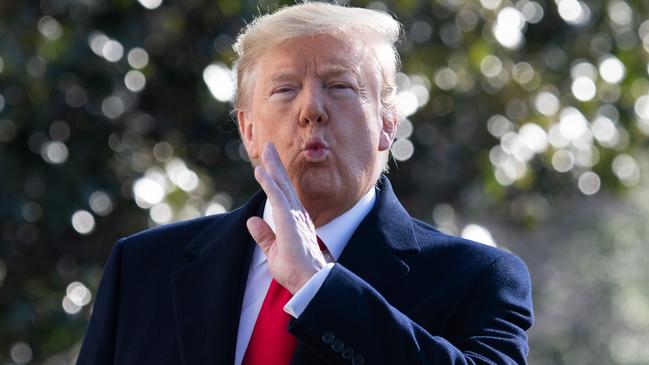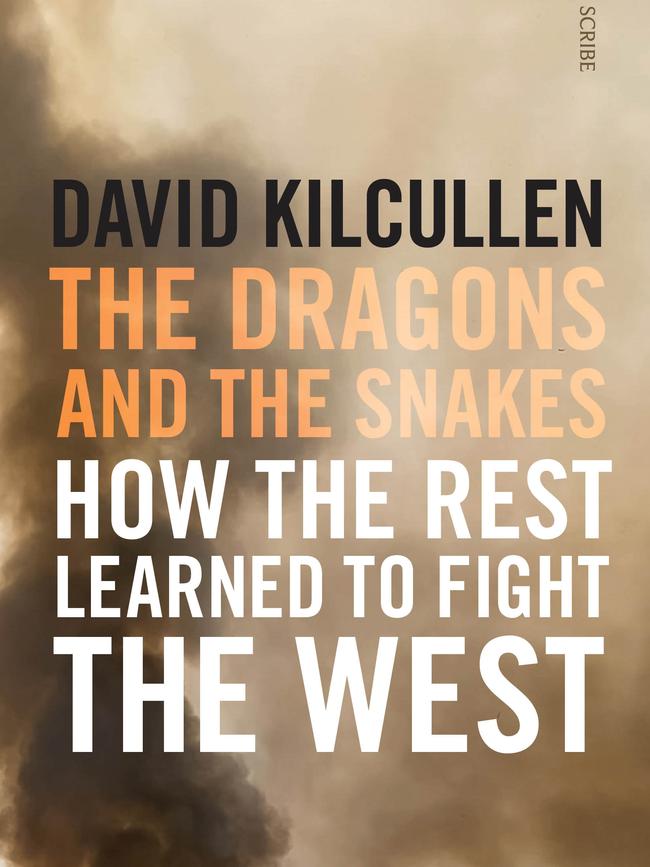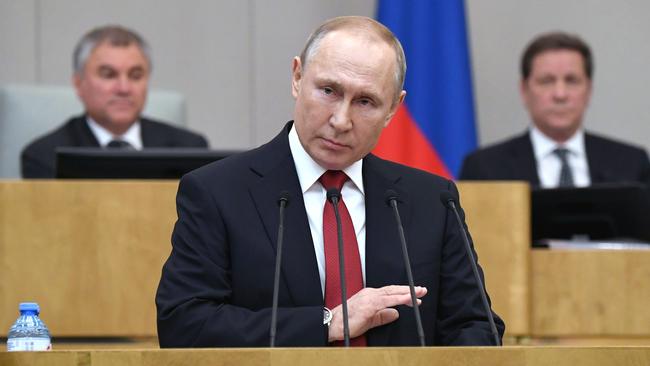
As China’s state news agency, Xinhua, noted on March 4, the US imports most of its surgical masks and more than 90 per cent of its pharmaceuticals from China. Responding to the “unkind” travel ban imposed by Washington after the virus ravaged Wuhan, Xinhua threatened that Beijing could retaliate by imposing strategic control over medical products and banning exports to the US.
Given escalating US-China tensions, trade wars, tariffs and competition for 5G telecommunications networks, the pandemic has not only accelerated the decoupling of the world’s two largest economies, but is also increasingly seen as part of a broader national security issue.
China’s militarisation of disputed territory in the South China Sea, its state-sponsored technology theft and cyber-intrusion into Western democracies, its strategic purchases of critical infrastructure across Europe, Latin America and the Asia-Pacific, building of bases in Africa and Southeast Asia, and development of advanced missile technologies, drones and warplanes, are only part of this pattern. Beijing’s acquisition, for the first time since the mid-15th century, of a bluewater navy that can project power across much of the globe, along with its ability to weaponise its economic influence over world markets, commodities and supply chains, marks a transformation in global power structures that threatens to destabilise the international security environment.
This return of great-power military competition — what some have dubbed a “Cold War 2.0” — is a stark contrast to the complacency of the 1990s. After winning the Cold War and achieving a stunning battlefield victory over Saddam Hussein in 1991, Western powers (the US, NATO, and allies such as Australia and Japan) seemed unassailably dominant. They expanded NATO into formerly Soviet-controlled Eastern Europe, launched interventions in Somalia, the Balkans, Sierra Leone and East Timor, and sought to remake the world in their own democratic, capitalist, pluralistic image.

James Woolsey, US president Bill Clinton’s first CIA director, gave a remarkably prescient overview of the threat landscape in the 1990s when he testified in 1993 that the US had “slain a large dragon … but now we find ourselves in a jungle filled with a bewildering variety of poisonous snakes”.
For most of the 90s, Western powers worried about those snakes — weak states, failing states and non-state actors such as terrorists.
Their approach to the “dragons” — the peer and near-peer state adversaries of the Cold War — was to co-opt and thereby normalise them: Russia through economic shock therapy and privatisation, China through trade liberalisation.
Hopes that democratisation would follow economic interdependence, that Moscow and Beijing would accede to a world order dominated by the US, or that Western military dominance would deter future wars by making them obviously unwinnable for all potential adversaries, turned out to be wildly overoptimistic. US secretary of state Madeleine Albright’s February 1998 assertion that “if we have to use force, it is because we are America; we are the indispensable nation; we stand tall and we see further than other countries into the future” seems ridiculously naive and hubristic in retrospect.
Albright was speaking in the context of a bombing campaign against Iraq, and it was the invasion of Iraq almost exactly five years later, in March 2003, that marked the high tide of the Western way of war, the hi-tech, precision-guided, battlefield-centric, system-of-systems approach the US had pioneered in 1991. It has all been downhill from there.
If the Gulf War showed adversaries how not to fight the West — in the open, conventionally arrayed in force-on-force battle — then the Iraq War and the seemingly endless series of inconclusive campaigns that followed showed how the Western way of war could be countered.
Non-state “snakes” learned to use amorphous, cell-based structures, blend into increasingly urbanised battlefields and hide among populations we barely understood. They repurposed Western consumer technology including drones, smartphones and GPS devices (which now outnumber people on the planet) to achieve levels of precision and lethality that were once the sole preserve of nation-states. And the explosion of internet and mobile phone connectivity allowed them to hide in the electronic clutter, while enabling rapid sharing of knowledge among groups who increasingly copied each other.
For their part, state adversaries — standing aside from the post-9/11 wars — were free to observe, learn and adapt even as we struggled to extricate ourselves from a quagmire of our own making. Russia under Vladimir Putin defeated a separatist guerrilla threat in Chechnya, then attacked and threatened its neighbours in Georgia, Scandinavia and the Baltic states, using both conventional military forces and unconventional capabilities such as cyber-militias, manipulation of migration, control of crucial natural gas supplies to western Europe, political warfare and targeted assassination of rivals.

Russia’s conventional forces modernised dramatically after 2011 under the New Look reforms, as did its nuclear missile technology. Moscow treated atomic missiles as a sort of gigantic artillery for fighting in conventional conflicts, rather than (as Western leaders typically see them) militarily unusable super-weapons whose purpose is to deter wars, not fight them.
By 2014, Russia had invaded and annexed Crimea, engaged in a barely concealed invasion of Ukraine, and was sponsoring separatist militias, who shot down Malaysia Airlines Flight MH17, killing all 298 passengers and crew.
The following year, Russian forces intervened in Syria, rescuing the collapsing regime of Bashar al-Assad and re-establishing Moscow as a Middle East player. Russia installed nuclear-capable Iskander missiles in its Baltic enclave of Kaliningrad, began working to woo Turkey away from NATO, and launched campaigns of political interference in the US and several European countries. The dragon was back.
Smaller countries, notably Iran and North Korea, exploited Western tunnel vision on terrorism after 9/11, along with the US-led coalition’s inability to extricate itself from Afghanistan and Iraq, to pursue a similar combination strategy — improving and expanding their conventional forces, sponsoring criminal networks, launching terrorist and cyber attacks, and pursuing nuclear weapons and the advanced missiles to carry them.
China, too, engaged in a combination of conventional and asymmetric warfare as it sought to establish itself as a peer competitor to the West. Beyond the tools already mentioned, China’s “Three Warfares” doctrine — published in 2006 — called for “public opinion warfare”, legal warfare or “lawfare”, and cyber warfare.
China focused on becoming a maritime power through its navy-building program, building space (including space warfare) capabilities, dramatically improving its nuclear and non-nuclear missile capabilities, and expanding its influence globally by translating economic power into political influence.
The reactions to this year’s coronavirus outbreak show just how different today’s environment is. American global leadership, such a core assumption of the post-Cold War world that Albright could confidently call the US “indispensable”, seems shakier now. The world today is much more multipolar, with competing power centres and rival regional blocs, than at any time since the Cold War. This is one reason why unified and collaborative global actions to confront the coronavirus have been conspicuously absent — one need only compare today’s efforts with the co-ordinated, US-led attempt to mitigate the global financial crisis in 2008 to see the difference.
This is partly explained by US President Donald Trump’s America-first approach, his trade wars with allies and adversaries alike, his bullying of fellow democratic leaders while acting in curiously ingratiating ways towards autocrats. Trump’s ambiguous messaging on NATO and other allies reflects his mercurial temperament and disregard for traditional diplomatic niceties.
But the underlying reason has nothing to do with the personality of the President. Rather, it reflects something much more basic: the loss of effectiveness of the Western military model that underpinned the modern world as we knew it, the rules-based international order that many took for granted.
In this sense, Trump is a symptom not a cause, in that his election reflected the American people’s loss of confidence in elites, experts and conventional wisdom. This collapse of confidence, in the face of two decades of exhausting, expensive and inconclusive military operations, is hardly surprising — indeed, it’s astounding that it took so long for American voters to push back, having seen years of failure while being blithely told their country had the best military in history. The wave of populism, elite exhaustion and expert dysfunction that has swept the West in recent years tells the same story.
In effect, since the Cold War, Western militaries have become victims of their own (conventional) success, and are now dealing with decadence and stagnation, having become the apex predator in a dynamic conflict ecosystem after 1991, only to find themselves locked in a drawn-out struggle with one snake — transnational Islamic extremist terrorism — after 9/11, while everyone else adapted around them.
This is Part 1 of a two-part series exploring key ideas in David Kilcullen’s new book, The Dragons and the Snakes: How the Rest Learned to Fight the West (Scribe). Part 2 will consider ideas on how Western powers, including Australia, might respond.




The rapid spread of COVID-19 from the Chinese city of Wuhan has killed thousands (and counting), while imposing massive disruption on international travel networks, integrated economies and globalised supply chains. It highlights the risks that accompany the benefits we all enjoy from the free movement and connectivity we take for granted today, as well as the extraordinary degree to which Western countries now depend on China for critical commodities.